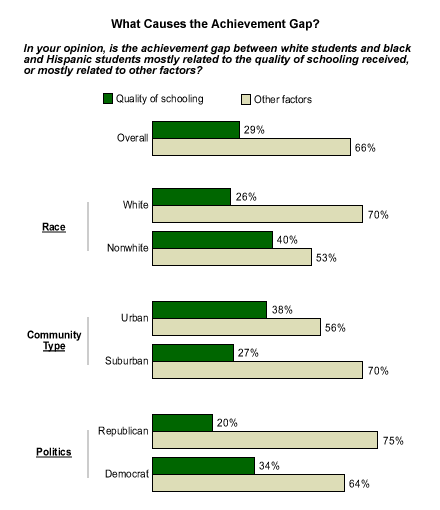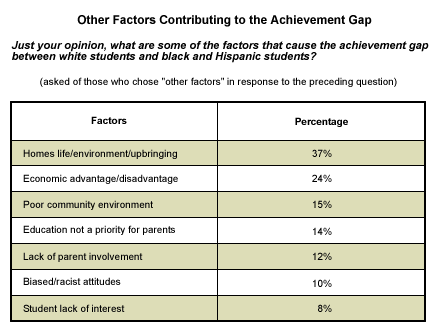No Child Left Behind: The title of the landmark education act ratified last January conveys a lofty goal, given the nation's high school dropout rate* is approximately 11%, according to the U.S. Census Bureau. The rate is higher among minority students (13% for blacks, and 15% for Hispanics born in the United States). Further, 2002 SAT data show that the gap between the scores of whites and most minorities is holding steady: blacks averaged 430 on the verbal section and 427 on math, compared to 527 and 533, respectively, for whites.
Â鶹´«Ã½AV/Phi Delta Kappa data** provide some insight as to why the academic achievement gap issue is so contentious. Respondents were asked "Just your impression, is the academic achievement of white students, nationally, higher, lower or about the same as that of black and other minority students?" Only about half of Americans (49%) are aware that such gaps even exist, and of those***, 66% say they don't see the problem as one of education quality but of other factors related to the students' backgrounds.
Adding to the problem are the barriers to providing equal educational opportunities, the most obvious of which is a funding gap driven by school districts' reliance on local property taxes. Lawsuits to rectify the funding inequities have been brought in 44 states, but some have been pending for decades. NCLB should improve the situation somewhat. Last July, Republican education leaders released an analysis of 125 of America's most disadvantaged school districts, which indicated that all would receive a dramatic boost in federal education funding.
But in the absence of complete funding reform, the chicken-and-egg dilemma remains -- surely, both educational and non-educational factors contribute to the gap, but perceptions about which is more important have real consequences as policy-makers decide how to allocate resources. Do you tackle expensive and politically problematic education reform in the hope that doing so will help kids escape poverty? Or, do you try to improve their families' economic status first, with the hope that doing so will allow students to perform better academically? What's the best way to "leave no child behind"?
Point of Consensus
Regardless of their perspective on how to address it, those who are aware of the minority achievement gap are likely to express concern about it. Eighty percent say it is very important to close the gap, with another 17% saying it is somewhat important. Those figures suggest a higher degree of consensus than last year, when 66% said such efforts are very important, 22% somewhat important.
Competing Explanations
Moving beyond the importance of the problem to its causes, consensus erodes somewhat. But it doesn't disappear -- of those aware of the minority achievement gap, only 29% say it is mostly related to the quality of schooling received, while a 66% say it is related to other factors. The good news for education reformists is that those figures have shifted slightly toward the school quality explanation: last year, 21% of respondents gave that response, while 73% cited other factors.

Who's most likely to blame the education system? Nonwhites and urbanites, who are more likely to live in low-income areas, are also more prone to see the achievement gap as an education quality issue. Politically, Democrats are more likely than Republicans to point to education disparities as its key cause.
Those who cited "other factors"**** were asked to say what they think might contribute to the gap. The most frequently named reason was the home life of the students, followed by economic hardships, poor community environment and lack of parental involvement. Racism itself was cited by only about 10% of those respondents.

Key Points
There's little doubt that considerable disparities exist between school districts in affluent areas and those in low-income communities, but one of the barriers to eliminating them is that much of the public seems to be unaware of the problem. Even those who are aware of the achievement gap between white students and minority students tend to view the causes as outside the schools' control.
Regardless of the relative importance of the factors causing the achievement gap, providing more equitable educational opportunities will have a positive impact. Policy-makers should be aware that attempts at funding reform may significantly benefit from a public relations effort to provide those in more affluent districts with evidence that even a slight adjustment in funding equity could make a huge difference for minority and low-income students.
*Status dropout rates provide cumulative data on dropouts among all young adults within a specified age range. Unlike "event" dropout rates, status rates include all dropouts in a given age range, regardless of when they last attended school. Status rates are considered to reveal the extent of the dropout problem in the population.
**These results are based on telephone interviews with a randomly selected national sample of 1,000 adults, aged 18 and older, conducted June 5-26, 2002. For results based on this sample, one can say with 95% confidence that the maximum error attributable to sampling and other random effects is ±3%.
***Those who think achievement of white students is higher: Sample size: 510. For results based on this sample, one can say with 95% confidence that the maximum error attributable to sampling and other random effects is ±5%.
****Those who cite "other factors": Sample size: 354. For results based on this sample, one can say with 95% confidence that the maximum error attributable to sampling and other random effects is ±5.5%.